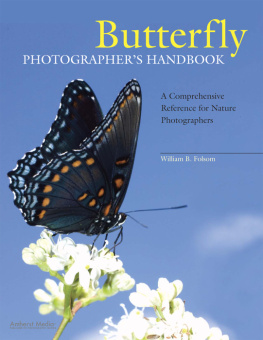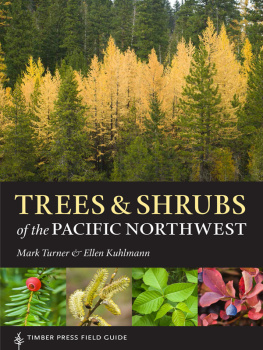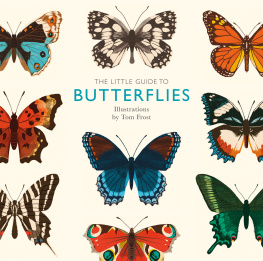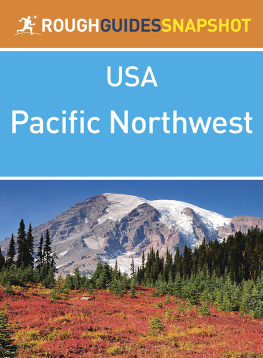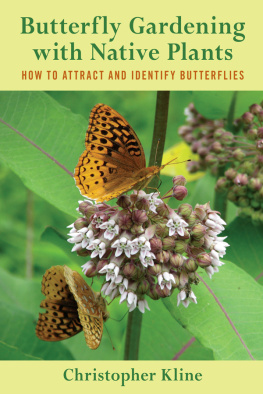
Pale Crescent (Phyciodes pallida), male.

Boisduvals Blue (Icaricia icarioides pembina), male.
BUTTERFLIES
of the PACIFIC NORTHWEST
Robert Michael Pyle and Caitlin C. LaBar
Scientific Advisers: Jonathan Pelham, Andrew Warren, Jon Shepard,
David James, David Nunnallee, Paul Hammond, David McCorkle,
Dana Ross, Paul Severns, David Droppers, Norbert Kondla
TIMBER PRESS FIELD GUIDE
To the memory of Thea Linnaea Pyle, John Hinchliff, Idie Ulsh,
and all other lovers and students of Pacific Northwest
butterflies who went before RMP
To Braden, Arthur, Jasmine, Rhiannon, Annabella, and all
my other butterfly-loving young friends, may this book
assist your future adventures CCL

Oregon Swallowtails (Papilio machaon oregonia), pair.

Purplish Copper (Lycaena helloides), male.
CONTENTS

Lustrous Copper (Lycaena cupreus), male.
INTRODUCTION
In the summer of 1967, I was a 20-year-old undergraduate at the University of Washington. Instead of returning to a summer job as a Denver postman, I remained in Seattle to try to teach a class on the natural history of butterflies. In the half-century since, I have taught hundreds of such classes, but back then the idea was a novel one; no one knew what to make of it. At the first class meeting, only one student showed up: a rising Garfield High School junior named Jonathan P. Pelham. It soon became apparent that Jon knew as much about butterflies as I did, and much more about the local species. I dropped the pretense of the class, got a job with the Sierra Club, and became instant field colleagues with Jona relationship we have now enjoyed for 50 years.
Before long, we decided a Washington butterfly book was needed. Starting with Ben Leightons 1946 checklist, and with the assistance of all the local collectors, we began the Northwest Lepidoptera Survey and a book project. Jon Shepard, then at the University of California at Berkeley, contributed his large set of records. Grant W. Sharpe, my postgraduate professor in the College of Forest Resources, enabled me to write an interpretive field guide to the states butterflies as a masters thesis. Hazel Wolf and Earl Larrison paved the way for it to be published in Seattle Audubon Societys Trailside Series as Watching Washington Butterflies ( WWB ) in 1974.
Jon Pelham became Curator of Lepidoptera at the Burke Museum and proceeded to build a superb reference collection and data base. Not only WWB but also my 1976 doctoral thesis on the ecogeography of Washington butterflies and Washington Butterfly Status Report and Conservation Plan (1989) owed a great deal to Pelhams data and review. Around 1978, a group of lepidopterists (Jon Pelham, Jon Shepard, John Hinchliff, Dave McCorkle, and I, and later Paul Hammond) came together as the Evergreen Aurelians, with a view toward expanding the Northwest Lepidoptera Survey by assembling records from scores of collectors, and through further field work. The labors of the Evergreen Aurelians came to fruit in the form of atlases of Oregon and Washington butterflies, edited and prepared by master datakeeper and mapmaker John Hinchliff (1994, 1996). These works summarized the distributional knowledge of a century of butterfly study in the Pacific Northwest.
In the succeeding years, Ernst Dornfelds classic Butterflies of Oregon (1980) and James R. Christensens very useful Field Guide to the Butterflies of the Pacific Northwest (1981) both came into print and went out again, as had WWB . William Neill and Douglas Hepburns Butterflies Afield in the Pacific Northwest (1976) helped to fill the gap. Demand for a new regional treatment led to my much-expanded Butterflies of Cascadia ( BOC ) in 2000. Crispin Guppy and Jon Shepards rich and detailed Butterflies of British Columbia (2001), Andrew Warrens brilliant and extremely thorough Butterflies of Oregon (2005), Jonathan Pelhams magisterial Catalogue of the Butterflies of the United States and Canada (2008), and David James and David Nunnallees thrilling Life Histories of Cascadia Butterflies (2011) all pushed our knowledge of the regions fauna further.
In recent years, with the rapidly blooming clientele for butterfly watching, gardening, and study, Juree Sondker at Timber Press felt that it was time for a new field guide to succeed Cascadia, and the present book was born. Along with the same stellar cast of collaborators and advisers that had richly informed Cascadia, I recruited one of our most talented and well-equipped young butterfly scientists, Caitlin LaBar, as co-author.
David Nunnallee adapted the Hinchliff dot maps as shaded range maps for Cascadia. Since then, many new distributional records have come in, and the Cascadia maps have been modified to bring our picture of species distribution up to date. WWB (1974) was the first American field guide to use color photographs of butterflies from life, and I was one of the few people photographing butterflies in the region at the time. By the time Idie Ulsh, Dave Nunnallee, and I assembled images for BOC , we found there were many more photographers, and we had a surfeit of fine images to choose among. These were all still color slides, and BOC was one of the last major field guides to use them. Now, since the digital revolution, many people are photographing butterflies, and the choice is bewildering. Caitlin LaBar has wrangled, assembled, and curated the many new digital images submitted, along with some converted originals from BOC . Our scientific advisers have vetted our final selections for species identifications and gender assignments.
We have learned much in the years since BOC was published in 2002. The book you hold in your hands, Butterflies of the Pacific Northwest, follows on from that book, but it is more than a revision. We have attempted to gather the current state of our butterfly understanding in the region into a palatable, friendly, reliable, up-to-date, and highly usable form. It is intended for everyone who wishes to study, watch, collect, photograph, garden, or otherwise enjoy butterflies responsibly. While many questions remain about their exciting biology, I hope you will find what you wish to know about our regions butterflies in these pages, or at least enough to frame your questions and pursue your own answers in the field and in the literature. With care and attention, you should be able to identify most of the 200+ species of butterflies you might encounter between Canada and California, Idaho and the Pacific, with the tools provided here.
In 1974 ( WWB ), I wrote, If the book helps you to see butterflies as necessary elements of an imperiled life matrixor simply to see butterfliesit will have achieved its purpose. Now, with the deepened ecological crisis in mind, I can say nothing truer of my hopes for this Timber Press Field Guide,
Next page

